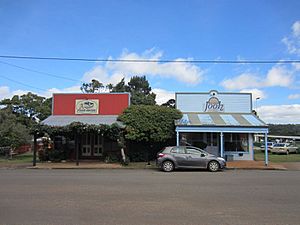7-9 Cedar Street, Yungaburra facts for kids
Quick facts for kids 7-9 Cedar Street, Yungaburra |
|
|---|---|

7-9 Cedar Street, 2015
|
|
| Location | 7-9 Cedar Street, Yungaburra, Tablelands Region, Queensland, Australia |
| Design period | 1919 - 1930s (interwar period) |
| Built | 1920s |
| Official name: 7-9 Cedar Street, Yungaburra | |
| Type | state heritage (built) |
| Designated | 15 March 1996 |
| Reference no. | 600480 |
| Significant period | 1920s (fabric) |
| Lua error in Module:Location_map at line 420: attempt to index field 'wikibase' (a nil value). | |
7-9 Cedar Street, Yungaburra is a special pair of old shops in the town of Yungaburra, Queensland, Australia. These buildings were built a long time ago, in the 1920s. They are important because they show how the town used to look. Because of their history, they were added to the Queensland Heritage Register on March 15, 1996. This means they are protected so people can learn about them in the future.
Contents
A Look Back: The History of These Buildings
These two wooden buildings, each with one floor, were built around the 1920s. One was used as an office, and the other was a cafe.
Yungaburra's Early Days
The town of Yungaburra was first called Allumbah Pocket. This name meant "red cedar," which was a common tree in the area. In 1886, a surveyor named Rankin mapped out the town. This was part of a plan to create new villages.
The Railway Arrives
A big change happened in 1910 when the railway line reached Yungaburra. This line connected the town to Cairns and Millaa Millaa. The town's name was changed to Yungaburra to avoid confusion with another town.
A Boost from Tourism
In 1926, the Gillies Highway opened. This new road made it easier for tourists to visit the nearby lakes. More visitors meant the town grew even more. This was a second time the town saw a lot of development.
Who Owned the Land?
The land where these buildings stand was first divided up in 1911. Kathleen Bullman bought it then. Later, in 1923, Patrick McChoy owned the property. By 1929, a local company called Estate HS Williams Ltd. took over. Pictures from 1929 show that the buildings were already there. One shop was an auctioneer's office, where things were sold. The other was a cafe. This cafe was handy for people visiting the Tivoli Theatre, which was right across the street.
What the Buildings Look Like
The two buildings at 7 and 9 Cedar Street are made of timber. You can see the wooden frame on the outside. They have corrugated iron roofs that are shaped like a triangle (called a gable roof). They stand on a slope, facing Cedar Street. There is a space between the two buildings with a small wall facing the street.
Special Features
Both buildings have similar square walls at the top, called parapets. They also have awnings that stick out over the front. These awnings are made of timber and iron and are held up by strong, curved wooden brackets. Round wooden posts also help support these awnings. Both buildings have large display windows and doors that are set back a bit. On the sides, there are window covers made of wood and corrugated iron. The windows themselves are a mix of ones that open outwards (casement) and ones that slide up and down (sash).
Inside the Buildings
The building at No. 7, which was a residence, has been changed inside. Some walls have been removed, and new ones added to create a bathroom, kitchen, bedroom, and living area. The shop at No. 9 is longer. It has a wooden lean-to at the back and a newer addition made of corrugated iron. Inside, the shop also has a new layout. There's a display area at the front, a bedroom, and a storage area behind it.
Why These Buildings Are Important (Heritage Listing)
7-9 Cedar Street, Yungaburra, was added to the Queensland Heritage Register on March 15, 1996. This means they meet certain important rules.
Showing History
These two timber buildings from the 1920s are important because they show how Queensland's history unfolded. They especially help us understand how Yungaburra and the Atherton Tableland area grew over time.
Typical Country Town Buildings
The buildings are a great example of what small commercial buildings looked like in country towns during the 1920s. They show the main features of that type of architecture.
Beautiful and Important to the Community
The buildings have a special look that the local people value. Their size, shape, and the materials used (like timber) make Cedar Street and the whole town of Yungaburra look unique. They are part of a group of old wooden buildings from the early 1900s that fit together nicely.

